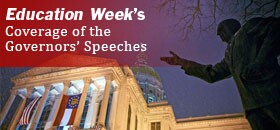Includes updates and/or revisions.
Against the backdrop of another smothering budget crisis, California Gov. Jerry Brown has quickly moved to put his stamp on the state’s public schools by shaking up the state board of education and entrusting its members with more power.
In some of his first moves, the newly inaugurated Democrat eliminated the position of education secretary—an advisory post separate from the state’s elected schools chief—and canned seven members of the state board, replacing them with former school superintendents, a teachers’ union activist, and a well-known Stanford University education professor.
Mr. Brown, who also served as governor from 1975 to 1983, replaced, among others, Ted Mitchell, the president of NewSchools Venture Fund, and Johnathan Xavier Williams, the founder of a charter school organization in Los Angeles. Also jettisoned was Ben Austin, a director at a Los Angeles-based nonprofit called Parent Revolution. That group is helping parents take advantage of a new state “parent trigger” law that gives them unprecedented power to turn around their own failing schools. (“‘Parent Trigger’ Law’s Use in California Draws Controversy, National Attention,” Jan. 12, 2011.)
Critics charge that the governor swapped members who were strong on teacher accountability and charter school growth in favor of school practitioners and teachers’ union supporters. In response, gubernatorial spokesman Evan Westrup said: “Governor Brown consults with a wide range of individuals when evaluating potential candidates and has appointed a diverse, well-qualified, and knowledgeable group committed to improving education in California.”
New board members include Michael W. Kirst, a professor emeritus at Stanford University, who advised Mr. Brown’s campaign and served on the board previously; Trish Boyd Williams, the executive director of EdSource, a nonpartisan research organization; Carl A. Cohn, a former superintendent of the San Diego and Long Beach school districts; and Patricia Ann Rucker, a legislative advocate for the California Teachers Association, which endorsed Mr. Brown during his campaign.
No Education Secretary

Education is feeling the pinch as state budgets tighten nationwide. Read what the governors plan for education funding and reform in 2011 in our State of the State and budget address roundups. Read more.
The , which were made without comment from the governor, came just two days after he was inaugurated. They coincided with his decision to eliminate the education secretary post, which he had promised during his campaign. The post was created under former Gov. Pete Wilson in the 1990s, but has largely served as a figurehead role with limited authority over education policy. California still has a separately elected state superintendent of public instruction, Tom Torlakson, who is in charge of running the education department.
During his campaign, Mr. Brown said he wanted to reduce the state’s education bureaucracy and rely more heavily on the board of education for policy guidance.
Gov. Brown’s original list of appointees included Bill Honig, a former state superintendent of public instruction who was convicted in the early 1990s on conflict-of-interest charges involving local schools and his wife’s nonprofit foundation. That appointment drew fire, and just days later, Mr. Honig withdrew his name.
Policy Choices
Gov. Brown’s education shake-up comes as the state board is weighing new regulations that would help districts implement the state’s new parent-trigger law, which lets parents vote to convert traditional public schools into charters, fire the principal, or close the school, among other options.
And because of the timing, proponents of that law see the appointments as a major step backwards.
“The education establishment is back in school again,” said Gloria Romero, a former state senator who ran unsuccessfully for the state chief’s job. She’s now the state director for Democrats for Education Reform, a New York City-based political action committee with chapters in several states. “I think this is a reverse of the forward progression that we have witnessed.”
There’s no doubt that with the elimination of the education secretary, “the state board will have more visibility and more impact,” said Mr. Kirst, one of the new board members. “This is a group of people who didn’t need a great deal of basic orientation to state education policy. The governor chose a board that could hit the ground running.”
But it is premature to criticize the governor for those appointments when the board hasn’t made any big decisions yet, he said. “I don’t think it’s fair. They don’t know what we’re going to do,” Mr. Kirst said.
During the campaign, Mr. Brown proposed scaling back the state’s testing program but making the results available more quickly and linking them to college and career readiness. He also wants to revamp the state’s school funding formula to consolidate many categorical programs and wants to improve teacher-preparation programs. His agenda does not speak to evaluating teachers based on student performance.
The California Teachers’ Association, which is affiliated with the National Education Association, hailed the new appointments.
“We commend Governor Brown for returning public school educators who reflect and understand the complexities of our public schools to the state board of education,” said CTA President David A. Sanchez in a statement.
Many expect Gov. Brown will need the help of labor unions to sell the public on a package of tax increases, which must be approved by referendum, meant to help balance a budget that’s out-of-whack by at least $25 billion. His budget proposal, unveiled last week, calls for $12.5 billion in severe cuts in most public services—including the state university system—and a short-term extension of personal and sales taxes.
Despite earlier warnings that he would have to make deep cuts to K-12, his budget plan mostly spared schools, keeping funding at $49 billion, or close to current levels.





